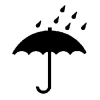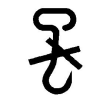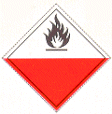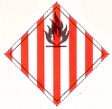| Ramie | [German version] |
Table of contents |
|
| General: | ||
| Product information | ||
| Packaging | ||
| Transport | ||
| Container transport | ||
| Cargo securing | ||
Product information
Product name
| German | Ramie |
| English | Ramie |
| French | Ramie |
| Spanish | Ramie |
| Scientific | Boehmeria nivea and Boehmeria viridis |
| CN/HS number * | 5305 9 ff. |
(* EU Combined Nomenclature/Harmonized System)
Product description
Ramie belongs to the category fibers/fibrous materials, which are classified as follows [24]:
Plant hairs:
| Cotton seed-hairs | |
| Kapok tree fruit hairs |
Stalk fibers from dicotyledonous plants (soft fibers):
| Flax, ramie (fine spinnable fibers) | |
| Hemp, jute, kenaf (coarse spinnable fibers) |
Leaf fibers (hard fibers):
| Sisal, Manila hemp, palm fibers (poor spinning characteristics) |
Bast:
| Linden, raffia palm, willow |
Basketwork material:
| Coconut fiber, rattan cane, halfa, piassava, esparto |
Ramie belongs to the natural vegetable fibers of the stinging nettle family (Urticaceae) and, like flax, is a soft fiber.
Ramie (Boehmeria nivea and Boehmeria viridis), considered the oldest cultivated plant of East Asia, is cultivated in particular in Indonesia, China, Japan and India.
Due its origin, it is also known as China grass. It is transported either as raw ramie (China grass) or as macerated ramie (obtained by boiling in an aqueous solution), i.e. degummed ramie.
1 – 2 m long rods as thick as a finger are obtained from the ramie plant. The fibers cannot be detached from these rods by retting, but instead the rods are split lengthwise and the bark is removed from the wooden core. The bundles of fibers are found in the bark. The up to 2 m long raw fibers are dried and chemically macerated to produce spinnable fibers.
Quality / Duration of storage
Ramie is a very fine, soft but strong (strongest natural fiber) and therefore high-quality spinnable fiber. It is pure white and lustrous.
Because it does not rot even when exposed to air and water, it is one of the most important vegetable fibers. This is why clothing exhibiting hardly any damage has been found in ancient pharaohs‘ tombs, for example.
China produces three qualities of ramie:
| „Yenkong“: highest quality | |
| „Wuchang“: medium quality | |
| „Poochie“: lowest quality |
Well-processed ramie is 99 – 99.5% cellulose, containing in particular no lignin (woody component).
Subject to compliance with the appropriate temperature and humidity/moisture conditions, duration of storage is not a limiting factor as regards transport and storage life.
Intended use
Ramie is a very high-quality spinnable fiber and is used to produce fishing nets, industrial yarns, filter cloths, underwear fabrics, suiting (tropical clothing), lining fabrics and lace and in paper manufacture. It is also frequently mixed with silk to produce damask and batiste.
Figure
(Click on the individual Figures to enlarge them.)
 Figure 1 |
 Figure 2 |
Countries of origin
This Table shows only a selection of the most important countries of origin and should not be thought of as exhaustive.
| Europe | Southern Europe |
| Africa | Africa |
| Asia | China, Japan, India, Philippines |
| America | Brazil, USA |
| Australia |
Back to beginning
Packaging
Ramie is transported in compressed and uncompressed bales, weighing 300 – 400 kg depending on degree of compression.
Raw ramie is generally dispatched unpackaged, while macerated ramie is packaged in jute fabric. The bales are strapped with steel strapping to ensure that they hold together better.
| Marking of packages | ||
 Keep dry |
 Use no hooks |
 Keep away from heat (solar radiation) |
Back to beginning
Transport
Symbols
 Spontaneously combustible, Class 4.2 IMDG Code |
 Fire hazard (Flammable solids), Class 4.1 IMDG Code |
 General cargo |
Means of transport
Ship, truck, railroad
Container transport
Standard containers , subject to compliance with water content of goods, packaging and flooring.
Cargo handling
In damp weather (rain, snow), the cargo must be protected from moisture, since ramie is strongly hygroscopic and readily absorbs and releases moisture. It may absorb up to 20% water vapor without feeling moist. Rusty steel strapping contaminates the fibers and reduces their value.
Do not use hooks for cargo handling, since they may lead to sparking when they come into contact with metal objects.
In addition, smoking is absolutely prohibited during cargo handling.
Stowage factor
| 2.27 – 2.41 m3/t (bales, uncompressed) [1] | |
| 2.37 – 2.41 m3/t (bales, uncompressed) [1] | |
| 1.42 – 1.56 m3/t (bales, compressed) [1] | |
| 2.23 – 2.37 m3/t (bales, uncompressed) [11] | |
| 1.39 – 1.53 m3/t (bales, compressed) [11] |
Stowage space requirements
Cool, dry
Segregation
Fiber rope, thin fiber nets
Cargo securing
The cargo is to be secured in such a way that the bales or strapping are not damaged. Undamaged strapping is essential to maintain compression of the bales during transport. If the strapping is broken, compression is diminished, which at the same time results in an increased supply of oxygen to the inside of the bales. This in turn increases the risk of combustion or feeds a fire which has already started. Bursting or chafing of the steel straps and wires may lead to sparking and external ignition.
Back to beginning
Risk factors and loss prevention
RF Temperature
Ramie requires particular temperature, humidity/moisture and possibly ventilation conditions (SC VI) (storage climate conditions).
Favorable travel temperature range: no lower limit – 25°C
Ramie must be stowed away from heat sources.
Every hold should be equipped with means for measuring temperature. Measurements must be performed and recorded daily.
Back to beginning
RF Humidity/Moisture
Ramie requires particular temperature, humidity/moisture and possibly ventilation conditions (SC VI) (storage climate conditions).
| Designation | Humidity/water content | Source |
| Relative humidity | 65% | [1] |
| Water content | 7.5 – 12% | [1] |
| Maximum equilibrium moisture content | 65% | [1] |
Ramie behaves strongly hygroscopically (hygroscopicity). It must be protected from sea, rain and condensation water and also from high levels of relative humidity, as the swelling capacity of the fibers may cause damage to the holds. It absorbs water vapor easily and quickly and releases it again quickly. It may absorb up to 20% water vapor without feeling moist. Rusting of the steel strapping must also be avoided.
Degummed ramie does not rot as easily, since it does not contain any pectin-type substances.
Back to beginning
RF Ventilation
Ramie requires particular temperature, humidity/moisture and possibly ventilation conditions (SC VI) (storage climate conditions).
If the product is loaded for shipment in a dry state, it does not have any particular ventilation requirements.
Problems arise if the product, packaging and/or ceiling/flooring are too damp. In this case, the following ventilation measures should be implemented:
Air exchange rate: 10 changes/hour (airing)
Since ramie very readily absorbs oxygen, before anybody enters the hold, it must be ventilated and if necessary a gas measurement carried out, since a shortage of oxygen may endanger life.
Back to beginning
RF Biotic activity
Ramie displays 3rd order biotic activity.
It belongs to the class of goods in which respiration processes are suspended, but in which biochemical, microbial and other decomposition processes still proceed.
Back to beginning
RF Gases
Ramie very readily absorbs oxygen. An oxygen shortage may therefore arise in closed holds and containers. Before anybody enters such holds, the holds must be ventilated and a gas measurement carried out where necessary.
An increase in CO2 and CO content indicates a cargo fire. The TLV of the hold air is 0.49 vol.%. As a result of the oxygen-rich lumen (cavity in fiber), bales often burn for weeks without being discovered.
Back to beginning
RF Self-heating / Spontaneous combustion
Ramie is assigned to Class 4.1 of the IMDG Code (Flammable solids). However, its specific characteristics and negative external influences (see below) may cause it to behave like a substance from Class 4.2 (Substances liable to spontaneous combustion) of the IMDG Code or ADR.
Its high cellulose content makes ramie particularly liable to catch fire through external ignition. Therefore, it must always be protected from sparks, fire, naked lights and lit cigarettes. Smoking is absolutely prohibited. Sparks may arise from bursting or chafing of the steel straps (and also as a result of inadequate cargo securing in the hold or container) and cause a cargo fire. In accordance with the IMDG Code, ventilation openings leading into the hold should be provided with spark-proof wire cloth.
Ramie must be stowed away from animal and vegetable fats/oils, oil-bearing seeds/fruits, copra and raw wool, since oil-impregnated fibers promote cargo fire.
Fire-fighting is best performed using CO2 or foam. It is very difficult to extinguish a fire because of the excess of oxygen in the fiber, which maintains the fire from the inside. When fighting a fire, do not break the steel straps or open the bales, since relieving the compression increases the oxygen supply and makes it impossible to fight the fire effectively.
Water must not be used for fire-fighting, since the swelling capacity of the cargo may cause damage to the holds.
Back to beginning
RF Odor
| Active behavior | Ramie is neutral in odor. |
| Passive behavior | Ramie is sensitive to unpleasant or pungent odors. |
Back to beginning
RF Contamination
| Active behavior | Ramie does not cause contamination. |
| Passive behavior | Ramie is sensitive to contamination by dust, dirt, fats/oils and rust as well as oil-containing goods, such as oil-bearing seeds/fruits, copra, raw wool etc., since oil-impregnated fibers promote self-heating/cargo fire. Holds or containers must accordingly be clean and in a thoroughly hygienic condition. Rust contamination may be caused by rusty steel straps, among other things. Since rust hampers the spinning process, this represents a reduction in value. |
Back to beginning
RF Mechanical influences
Care must be taken to ensure that mechanical influences do not cause damage to strapping, which increases the risk of fire by relieving the compression of the bale and allowing a greater supply of oxygen. Use no hooks.
Back to beginning
RF Toxicity / Hazards to health
Since ramie is highly oxygen-absorbent, a life-threatening shortage of oxygen may arise in the hold or container. Thus, before anybody enters the hold, it must be ventilated and, if necessary, a gas measurement carried out. The TLV for CO2 concentration is 0.49 vol.%.
Back to beginning
RF Shrinkage/Shortage
The product’s capacity readily to absorb and release water vapor may lead to weight loss.
Unclearly marked bales may result in losses of volume due to incorrect delivery.
Back to beginning
RF Insect infestation / Diseases
Leaf and stem spot, which cause blotchy fibers, are caused by the fungus Colletotrichium boehmeriae, which occurs in Japan and Taiwan.
Back to beginning
